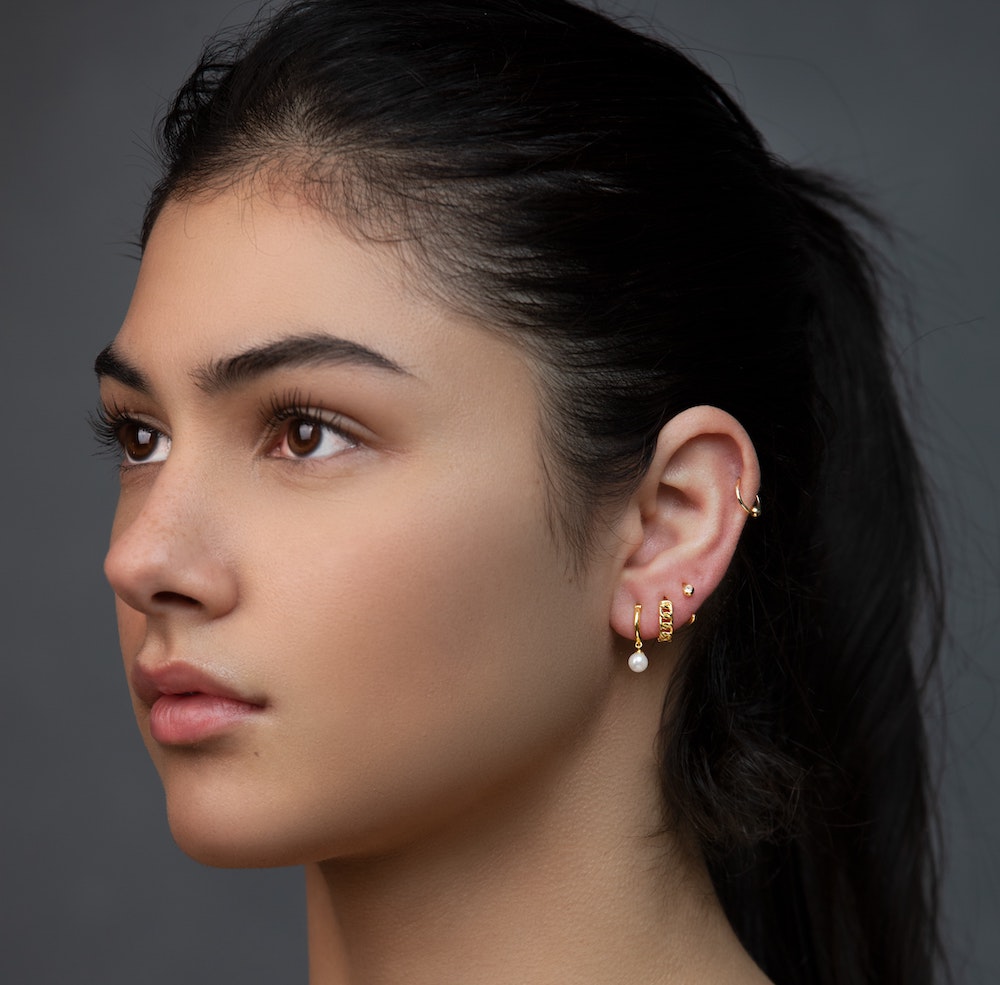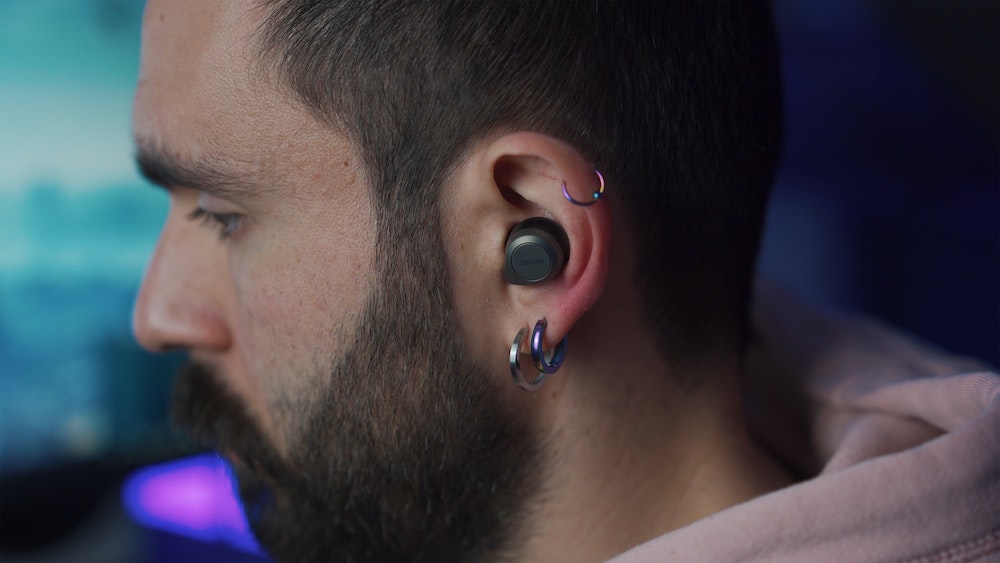The Lobe Piercing: Five Things You Might Not Know February 7, 2023 – Posted in: Piercing Advice, Piercing Types – Tags: caring for lobe piercing, ear piercing, ear piercing care, ear piercing facts, lobe piercing, lobe piercing aftercare, lobe piercing facts, types of lobe piercings
Highlights
- Research reputable piercers to conduct your lobe piercing. Don’t do it at home or at the mall.
- For traditional earlobe-sized jewelry, choose 18G or 16G for best healing.
- Give the same level of aftercare as you would any other piercing, and have a piercer confirm that your lobes have finished healing before stopping aftercare.
The lobe piercing is a piercing classic. Although it’s the most popular piercing by far, it also offers a lot of opportunities for customization. Its anatomy allows for versatile piercing placement, leading to double, triple, or even quadruple lobe piercings.
Its versatility has led to a surge of popularity in recent years. New lobe piercing styles, like triangle piercings and stacked piercings, are leading people to the piercing chair, and many are lining up to add to their lobe aesthetic.
There’s a common misconception, however, that lobe piercings do not need to be treated with the same level of care. People are more willing to submit to unreputable piercing practices and get a bit lazy with their aftercare practices because they don’t think that the lobe piercing requires as much care.
While it is true that lobe piercings are easier to heal than other piercing types, like cartilage piercings, it requires the same care and attention as any other piercing. Complications in lobe piercings are rare, but they do happen. You need to make sure that you are making good choices so that you can be happy with the result of your new lobe piercing.
Here are five things that you need to know about the lobe piercing before you get pierced.
1. Don’t skimp on the piercer
In spite of the fact that the lobe piercing has a reputation for being easy, there are certain considerations that only an expert piercer will be able to understand. Symmetrical placement of the lobe piercing can be tricky. Lobes vary greatly from person to person, and your left lobe can differ from your right. It takes a trained eye to properly place them; more than a minimum wage mall worker will have.
There are also various placement options for you to choose from. Your anatomy will not preclude you from getting a lobe piercing, so it will completely rely upon your preference. This can sometimes lead to a pressure of choice; when there are so many suitable options, how can you decide where you want your lobe pierced?
A reputable piercer with plenty of experience will be able to help you choose the piercing placement that you love. They’ll also consider things that you might not have thought of yet, like whether you’re planning to stretch your piercings or if you want to get more lobe piercings in the future. Choosing a reputable piercing is about more than safety (although, safety is a topmost consideration); they provide a level of expertise that you won’t find anywhere else.

Photo by H.F.E & Co Studio on Unsplash
2. Keep pillows, phones, and headphones clean while healing
If you think about it, our smartphones are disgusting. We take them everywhere, from the bathroom to dirty clubs. Then, we press that nasty surface to our ears, right next to our faces. While this is pretty gross at any time, it can cause concern when you’re healing a lobe piercing. To prevent the introduction of some nasty stuff to your lobe piercing, you might want to become a bit of a clean freak and thoroughly wipe down your phone on a daily basis.
Similarly, your pillowcases and headphones can get a bit dirty, too. You likely only wash your pillowcase once every week or so, and do you even remember the last time you gave your headphones a wash? To keep your lobe piercing safe, make sure that you use a clean pillowcase nightly (or cover your pillow with a clean t-shirt) and wipe down your headphones regularly.
Lobe piercing aftercare
To keep your lobe piercing clean, use a sterile packaged piercing aftercare saline solution to wash it 2 – 3 times daily. All you need to do is spray the solution onto a clean cotton swab, piece of gauze, or even a clean paper towel and gently dab it around the front and back of the piercing. When you do so, be careful not to move the jewelry around too much. If crusties have formed (which they likely will), do not pick at them. Instead, spray the saline solution directly onto the crusties to get them damp, then gently wipe them away with a swab, gauze, or paper towel.
3. You should opt for 18 gauge as a minimum for the post gauge, and seek out high-quality materials
Many people mistakenly believe that a very thin earring post will result in extremely small scarring of the ear. This is not the case. The wire-thin post can easily cut through the skin if the jewelry is forcefully tugged or if it’s too heavy. This results in larger holes and more obvious scarring. For this reason, piercers now recommend getting pierced at 18G or 16G.
Beyond gauge sizes, jewelry materials should also be an important consideration. Perhaps because of the ubiquity of lobe piercings, people are more willing to wear earrings made from poor-quality materials. While they take the time to carefully research their eyebrow or lip piercing jewelry, they will put nearly anything in their lobe piercings. Remember, they are still piercings and need to be treated the same as any other hole in your body. Make sure that you choose jewelry that is implant-grade compliant and durable, like 14k gold, niobium, or platinum. In addition, make sure that the manufacturer has expertise in body jewelry, and carefully vet your pieces.
Here is a detailed guide on how to choose the proper jewelry for your piercing.

Photo by Onur Binay on Unsplash
4. Never, ever use a piercing gun or pierce at home
90s kids grew up watching Lindsay Lohan pierce herself using a needle, ice, and an apple in The Parent Trap. This led us to the false conclusion that lobe piercings could be easily done at home if we’re brave enough. Besides the fact that it’s too easy to mess up lobe piercing placement (see above), there are loads of other considerations that you aren’t trained to know. Do yourself a favor, and invest in a professional.
Piercing guns were also very popular in the ‘90s. They should not be used under any circumstances. The piercing gun doesn’t use a specialized piercing needle. Rather, it forces the slightly sharpened earring itself through the ear. Obviously, this isn’t nearly as sharp as a piercing needle, and it damages the skin, causing discomfort. Additionally, the plastic components in piercing guns prevent them from undergoing autoclave sterilization—a must in piercing safety. Use of a gun can introduce your piercing to a plethora of microbes, putting your piercing at a disadvantage from the start.
5. Quick lobe piercing healing does not mean that you can slack on aftercare
The lobe piercing has one of the fastest healing times of any piercing—4 to 8 weeks. The fast healing time often leads people into a false sense of security, and they believe that aftercare isn’t as important as it is in piercings with longer healing periods. This is far from correct. Your lobe piercing is still a wound that needs to be healed and, throughout healing, it must be treated the same as any other piercing.
Here are some general piercing aftercare rules:
- Keep your piercing away from hats, dirty hair, pillows, or other objects that might introduce dirt and debris.
- Only use piercing aftercare saline solution with no additives on and around your piercing. Face wash, makeup, and other products contain irritating chemicals that can harm your piercing.
- Keep your piercing dry. After you shower, gently dab the piercing fully dry with a clean swab, gauze, or paper towel.
- Stay away from standing water like that found in tubs, hot tubs, or lakes.
- Before you stop aftercare practices or change your jewelry, have a piercer confirm that healing is complete. Piercings appear fully healed before they have completely healed internally.
The lobe piercing is a classic that offers a plethora of options. However, it still requires special care and attention; just because the lobe piercing is easy doesn’t mean that it deserves less care than any other piercing. Before you get pierced, make sure that you can take responsibility to heal the piercing, and don’t take that responsibility lightly.




